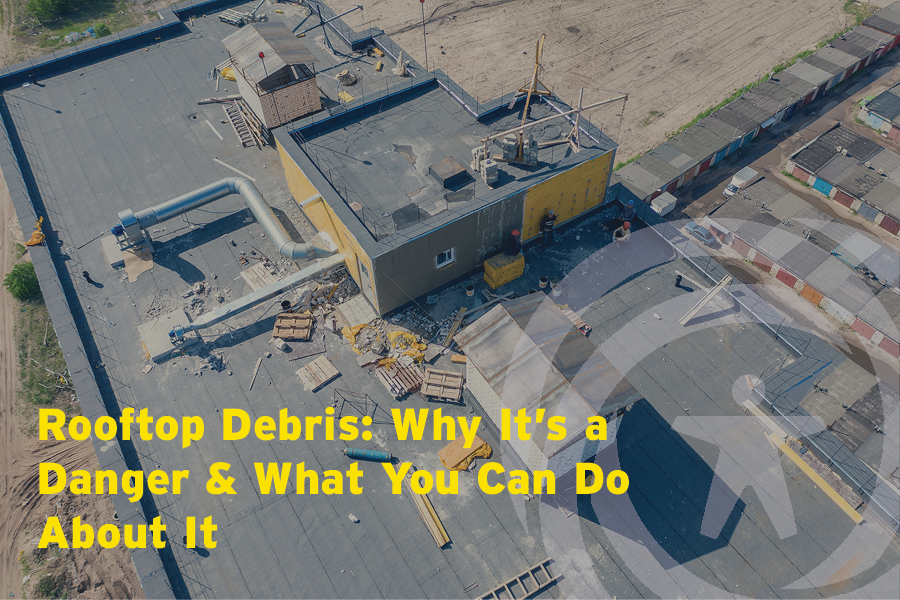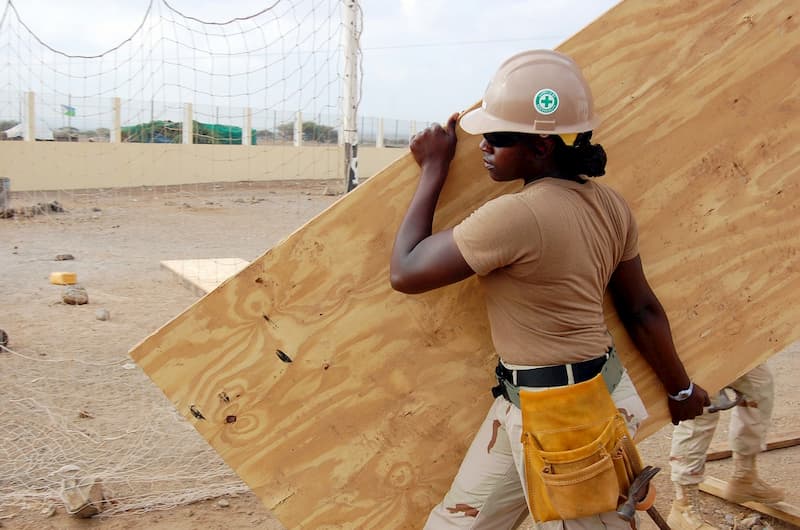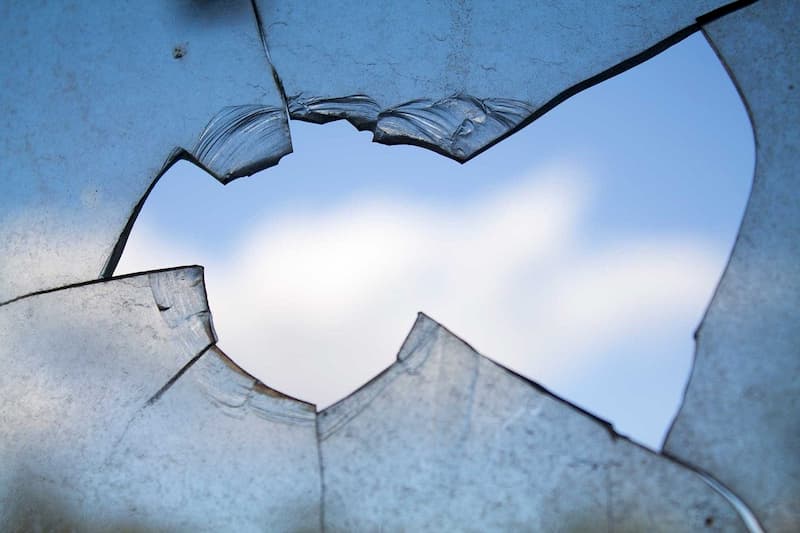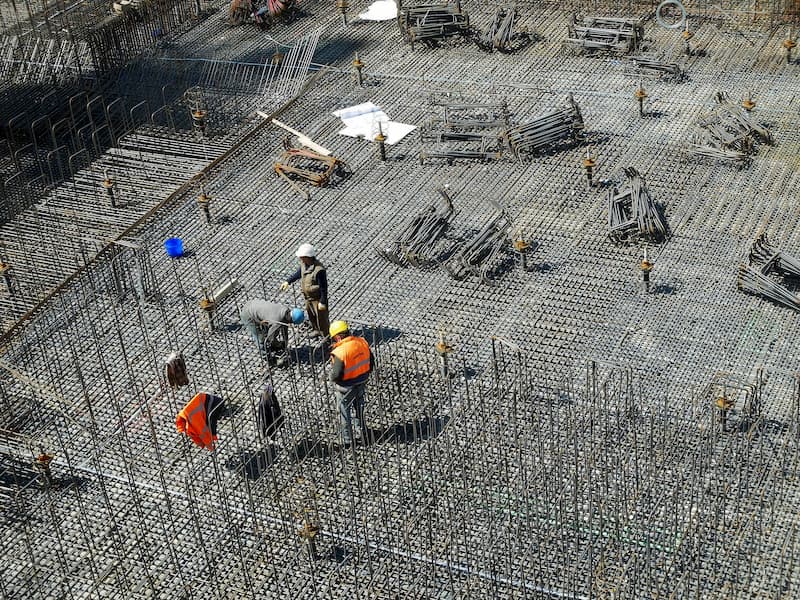Rooftop Debris: Why It’s A Danger And What You Can Do About It

Working at height is dangerous in itself. A misplaced step or compromised structure can result in serious injury or death. Add rooftop debris into the mix, and a hazardous environment becomes even more dangerous. Knocked down limbs, falling leaves, construction materials — anything left on your rooftop has the potential to hurt people at your job site, cause damage to your facility, and create big bills and expensive repairs.
What you’ll read about:
- How debris can injure people — projectiles, trips, slips, and hidden hazards.
- How debris can damage your facility — equipment, structure, and efficiency damages.
- Costs from damages and injuries would be higher than removing debris regularly.
- The methods and considerations for safely removing debris.
Why You Need to Worry About Rooftop Debris
It all boils down to three main concerns: injury to people, damage to your facility, and the costs associated with those injuries and damages.
Injuries at Your Facility
If you’re skeptical about how harmful debris could be, here’s a real-life example of the dangers: on a windy day, a rooftop audit was being performed. As they were assessing the roof, a piece of plywood was lifted by the wind and blew in the direction of a worker. Luckily, the safety consultant noticed the plywood and jumped on it to stop the trajectory, saving the worker from serious injury. However, even stopping the plywood was a highly hazardous act and could have resulted in a different ending.
If the plywood was simply cleared from the roof and properly stored, this scenario wouldn’t have happened and the two men wouldn’t have been put in danger.

Projectiles
As the previous example shows, leftover debris on your rooftop can be blown around and injure people on your roof as well as those on the ground. Had that plywood continued to fly away, it could have injured the worker as well as anybody unsuspecting down below. Leaves and light debris might not seem like a concern because of their size, but even small objects can be a projectile that can cut or puncture your gear or yourself. And, if the wind speed gets even moderately strong, it can pick up limbs, construction materials, and other objects that can severely injure people at your facility.
Trips & Slips
Even if the wind isn’t a major concern, debris on your roof can create trip and slip hazards no matter how large or small the object. Limbs or leftover materials can create barriers and obstacles that lead to injuries to unaware personnel. Likewise, slip hazards are often overlooked and underestimated. Leaves, trash, wrappers, shingles, tarps — there are a lot of objects that seem innocent but actually introduce major trip or slip hazards. If you think a slip or trip on the same level isn’t that big of a deal, think again. You could slip and puncture your hand on a nail, or cut your skin on glass from a skylight. The fall itself, even on the same level, could break bones or cause head injuries (always wear a helmet in hazardous areas!). Mixing slip and trip hazards with working at height amplifies the risk of a highly dangerous work environment that can cause serious injury and cost the business.
Hidden Hazards
While the debris itself can cause damage and injuries, it can also hide the hazards that already exist and cause otherwise avoidable accidents. Leaf build-up can cover skylights and holes while other hazards such as nails or roof vents get hidden from view. A small pipe along the roof becomes a trip hazard that could result in broken ribs. Everyone is at risk when hazards are hidden, whether you’re familiar with the roof or not.
Damage to Your Facility
Maintaining any property requires a lot of hard work and money, to begin with, but ignoring debris, trash, and leaves at your facility can cause damages that cost substantially more to repair and require a lot more time and effort.

“What are some of these types of damages?” you might be asking.
Projectiles (Again)
As the wind can blow debris and injure people, it can also damage anything on your roof. Debris can bash into units, hatches, lights, or the roof surface itself and cause damage that’ll force you to make repairs or even shut down your business. Even fall protection systems and equipment can be damaged, making them no longer compliant with OSHA safety regulations, putting personnel at further risk. Removing the debris before a storm happens (and preferably on a regular basis) can prevent serious damage and expensive repairs.
Degradation
Organic material rots and when enough of it rots on your roof, the structure itself can be compromised. This isn’t only a hazard for those walking or working on your roof, but for those down below. People in the building can be injured should the structure begin to collapse or holes in your ceiling form. In addition, openings in your roof can allow for wildlife or weather to enter your building and cause even more damage. It might be a slow process, but it can creep up on anyone if they’re not careful to maintain a clear roof.
Pooling Water
Roofs might be designed to ensure water will run off into gutters or drainpipes, but if debris blocks your gutters and drainage systems, it will cause water to pool on your rooftop. Standing water can damage the surface, rot the structure, and leak into other areas of your building, turning a big problem into a massive one. Clearing your gutters and drainage should be a regular part of your maintenance plan.
Efficiency
Many roofs are made to reflect the sun’s rays and keep the inside of the building energy efficient. Debris can block the surface of the roof and reduce the efficiency of this process while absorbing more heat into your building, increasing energy consumption to keep up with cooling your facility. Even worse, if holes begin to form in your roof then your heating and AC will be severely affected, causing discomfort for anyone inside and creating large energy and repair bills.
Cost For Business
Debris can have a big effect on your workers and the facility. Serious injury can result from debris itself and hide hazards from workers that otherwise could be avoidable. Even more, the public, as well as those working in the building, are at risk from debris falling from the roof or compromising the structure. All of these concerns should be alerting your business-finance senses. Accidents, injuries, death — should something happen, the business could be liable for hospital bills, worker’s compensation, and potential lawsuits, just to name a few.
Not to mention the costs of damage to the building itself. Stack the repair costs of facility units, structures, surfaces, and infrastructure on top of injury expenses and the business could be looking at hundreds of thousands, if not millions, of dollars from failing to take care of debris on the roof.

How To Safely Remove Debris From Your Roof
Removing debris is critical for keeping a safe environment at your facility and preventing costly damages or injuries from occurring. However, the process of debris removal is dangerous in itself. So, what are some ways you can mitigate build-up to keep people safe, your facility undamaged, and those major costs from racking up?
As Always, Safety First
Whenever possible, stay away from the hazards on your rooftop. You need to stay back by 15 feet or more from any unprotected roof edge, skylight, or access point. If you have to get closer, wear the appropriate PPE, and have a fall protection system, such as a lifeline system or safety railing, in place before attempting to access the area. Furthermore, don’t just clear your roof and call it a day. Make sure any debris that reaches the ground gets cleaned up so anyone down below won’t step on nails, trip over obstacles, or slip on wet leaves and trash. Safety is vital everywhere at your facility so that no one gets injured.
Choose the Right Day to Clear Debris
Picking a day with clear skies, minimal wind, and a moderate temperature will help you safely clear your roof of debris. Clear skies will ensure that rain or snow won’t fall in the middle of the job, introducing more risk to the situation with slippery surfaces or covered hazards. Low wind speeds will mitigate the chance of debris blowing into workers or falling to the ground injuring unsuspecting pedestrians below. Relatively moderate temperatures will keep workers from overheating or getting numb in the cold. Waiting for just a day or two for good weather could increase the safety of the debris removal process and mitigate more risk for everyone involved.
Organize as You Go
For any maintenance or construction work, it will help to clean up and organize as you go. This doesn’t mean constantly bringing debris back and forth from one area to another but keeping it compiled and out of the way. This will reduce the risk of tripping or slipping on the debris by keeping it in a designated area. Plus, it will make removing the debris altogether much easier at the end of the day.

Use a Leaf Blower
Leaf blowers are a go-to for leaf removal and can be used for other lightweight materials as well. However, it’s important to ensure you’re not blowing the leaves or other debris off the roof and into any area that could have traffic. Debris falling from the building can create hazards for anything that’s below, so make sure there are designated areas that don’t have anything that can be damaged or injured. Using a leaf blower could also blow debris into rooftop units, skylights, hatches, or other openings on your roof and cause damage to your equipment. Always use common sense and make sure you’re blowing debris into anything that can be damaged.
Raking, Bagging, and Chuting
Using a rake or long-handled brush is great for precisely moving debris around your roof. Some handles have a telescopic or extendible pole that can keep you further away from hazards and increase your safety. Once piles are formed, it’ll be easy to shovel the debris into trash bags or send it down a trash chute from the rooftop to the ground. A trash chute is one of the safest and most precise methods of moving debris off your roof and into a designated area. Just make sure the proper fall protection measures are taken if workers are nearing the edge for sending debris down a chute.
At the end of the day, everyone wants to work in a safe environment free of the hazards that debris can create. A trip over a brick can break an arm and pooling water can rot your facility’s structure — neither are wanted and both are expensive. Taking the time and effort to safely clear your facility of debris is vital in creating a safe workplace. While regularly maintaining your facility may take a small investment, it’s nothing compared to the cost of injuries and damages that could result from something as simple as debris on your rooftop.



